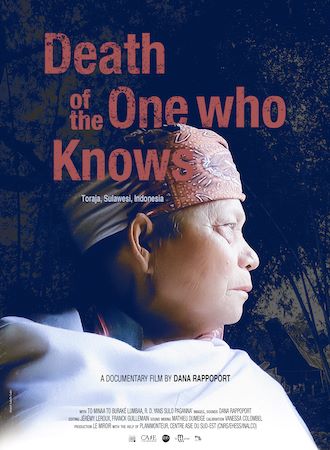
Death of the One Who Knows 2020
Distributed by Documentary Educational Resources, 108 Water Street, 5A, Watertown, MA 02472; 617-926-0491
Produced by Dana Rappoport
Directed by Dana Rappoport
Streaming, 82 mins
High School - General Adult
Anthropology; Documentaries; Social Problems
Date Entered: 09/27/2022
Reviewed by Joseph Baumstarck, Jr., University of Louisville, Southern Baptist Theological Seminary, Ivy Tech Community CollegeThe Toraja Highlands of Sulawesi Island in Indonesia provides the film's setting. For many years, Lumbaa has been one of the very few remaining residents who knows his people's ancient ritual speech and ritual activities. Due to forced mass conversion to Christianity, few residents of the area are interested in taking up ritual speech and ritual activities because of their ban by the area's authorities in 1945. Although forced to convert to Pentecostalism several years prior to this film, Lumbaa keeps some of the ancient speech alive and still remembers the ancient rituals. A slight resurgence in interest among neighboring areas allows Lumbaa to comment on ritual errors and well-meaning additions that have been added or left out of the traditional rituals and speech.
Yans Sulo, a young Catholic priest, recognizes the losses that occur when ancient ritual ways and speech die out, but he is too late to affect matters much. By the time Sulo gets involved, Lumbaa is well advanced in age, and Lumbaa dies after meeting Sulo, but before definitive work can begin to save the ancient speech and rituals. At Lumbaa's funeral, only portions of the ancient ritual survive. Lumbaa noted earlier that one of the ancient rituals contained 25,000 verses and required six whole, consecutive nights for its performance. Since even the funeral ritual is garbled, it is clear that this ritual no longer exists either.
The film does a good job of showing the scenery, people, culture, and some of the everyday rituals of this area. The film is slow-moving, with English subtitles throughout. The filmography and sound are very well done. Yans Sulo's honest effort to understand and ensure the continuation of these ancient rituals and speech is profoundly moving. Even though he fails at his ultimate goal, he does succeed in bringing some interest back to the area regarding these rituals. It is ironic and refreshing that a Catholic priest would play the protagonist's role in a film such as this without any evident repercussions to himself. There are traces in the documentary of projects going back at least twenty-plus years, which in various ways attempt to capture some of the ancient speech and rituals on film and tape. Unfortunately, the documentary does not further address this aspect which would have been very relevant.
Overall, the lack of interest in this film is evident. This film has few general interest aspects for a wider general audience. There is almost no internet presence for it, with only a few hits on an internet search after its release two years ago. The topic has broad applications, but there are many films that document better-known and more accessible anthropological issues like this. The heaviest users of this film will likely be academics specializing in Southeast Asia, specifically Indonesia. Since a broader range of academics working in related fields has better films they can choose from and are unlikely to use this film for their work and classes, a rating of Recommended with Reservations is the best that can be justified.
Awards: Honorable Mention for Best Documentary, International Council for Traditional Music; Honorable Mention for Werbner Award for Visual Anthropology, RAI Film Festival
Published and licensed under the Creative Commons Attribution 4.0 license. Anyone can use these reviews, so long as they comply with the terms of the license.